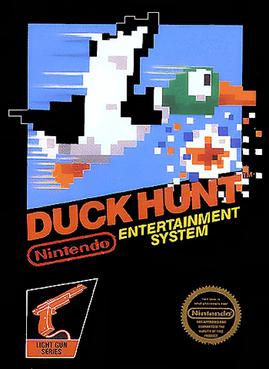
Duck Hunt is a 1984 light gun shooter video game developed and published by Nintendo for the Nintendo Entertainment System (NES) video game console and the Nintendo Vs. System arcade hardware. The game was first released in April 1984, in Japan for the Family Computer (Famicom) console and in North America as an arcade game. It was then released as a launch game for the NES in North America in October 1985, with it also releasing in Europe two years later.

The Nintendo 64 (N64) is a home video game console developed by Nintendo. It was released on June 23, 1996, in Japan; on September 26, 1996, in North America; and on March 1, 1997, in Europe and Australia. The successor to the Super Nintendo Entertainment System, it was the last major home console to use cartridges as its primary storage format until the Nintendo Switch in 2017. It competed primarily with the Sony PlayStation and the Sega Saturn.

The Super Nintendo Entertainment System, commonly shortened to Super Nintendo, Super NES or SNES is a 16-bit home video game console developed by Nintendo that was released in 1990 in Japan and South Korea, 1991 in North America, 1992 in Europe and Oceania, and 1993 in South America. In Japan, it is called the Super Famicom (SFC). In South Korea, it is called the Super Comboy and was distributed by Hyundai Electronics. The system was released in Brazil on August 30, 1993, by Playtronic. Although each version is essentially the same, several forms of regional lockout prevent cartridges for one version from being used in other versions.
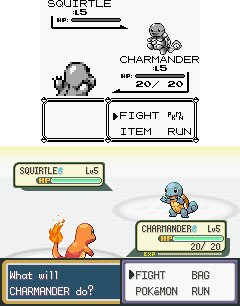
A video game remake is a video game closely adapted from an earlier title, usually for the purpose of modernizing a game with updated graphics for newer hardware and gameplay for contemporary audiences. Typically, a remake of such game software shares essentially the same title, fundamental gameplay concepts, and core story elements of the original game, although some aspects of the original game may have been changed for the remake.
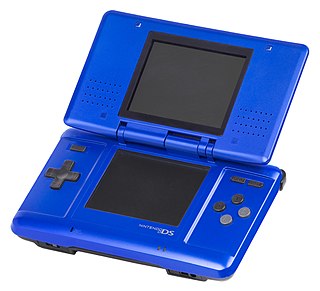
The Nintendo DS is a handheld game console produced by Nintendo, released globally across 2004 and 2005. The DS, an initialism for "Developers' System" or "Dual Screen", introduced distinctive new features to handheld games: two LCD screens working in tandem, a built-in microphone and support for wireless connectivity. Both screens are encompassed within a clamshell design similar to the Game Boy Advance SP. The Nintendo DS also features the ability for multiple DS consoles to directly interact with each other over Wi-Fi within a short range without the need to connect to an existing wireless network. Alternatively, they could interact online using the now-defunct Nintendo Wi-Fi Connection service. Its main competitor was Sony's PlayStation Portable during the seventh generation of video game consoles.

Multi-memory controllers or memory management controllers (MMC) are different kinds of special chips designed by various video game developers for use in Nintendo Entertainment System (NES) cartridges. These chips extend the capabilities of the original console and make it possible to create NES games with features the original console cannot offer alone. The basic NES hardware supports only 40KB of ROM total, up to 32KB PRG and 8KB CHR, thus only a single tile and sprite table are possible. This limit was rapidly reached within the Famicom's first two years on the market and game developers began requesting a way to expand the console's capabilities.
Homebrew, when applied to video games, refers to games produced by hobbyists for proprietary video game consoles which are not intended to be user-programmable. The official documentation is often only available to licensed developers, and these systems may use storage formats that make distribution difficult, such as ROM cartridges or encrypted CD-ROMs. Many consoles have hardware restrictions to prevent unauthorized development.

The history of the Nintendo Entertainment System (NES) spans the 1982 development of the Family Computer, to the 1985 launch of the NES, to Nintendo's rise to global dominance based upon this platform throughout the late 1980s. The Family Computer or Famicom was developed in 1982 and launched in 1983 in Japan. Following the North American video game crash of 1983, the Famicom was adapted into the NES which was brazenly launched in North America in 1985. Transitioning the company from its arcade game history into this combined global 8-bit home video game console platform, the Famicom and NES continued to aggressively compete with the next-generation 16-bit consoles including the 1988 Sega Genesis. The platform was succeeded by the Super Famicom in 1990 and the Super Nintendo Entertainment System in 1991, but its support and production continued until 1995. Interest in the NES has been renewed by collectors and emulators, including Nintendo's own Virtual Console platform.
A video game accessory is a distinct piece of hardware that is required to use a video game console, or one that enriches the video game's play experience. Essentially, video game accessories are everything except the console itself, such as controllers, memory, power adapters (AC), and audio/visual cables. Most video game consoles come with the accessories required to play games out of the box : one A/V cable, one AC cable, and a controller. Memory is usually the most required accessory outside of these, as game data cannot be saved to compact discs. The companies that manufacture video game consoles also make these accessories for replacement purposes as well as improving the overall experience. There is an entire industry of companies that create accessories for consoles as well, called third-party companies. The prices are often lower than those made by the maker of the console (first-party). This is usually achieved by avoiding licensing or using cheaper materials. For the mobile systems like the PlayStation Portable and Game Boy iterations, there are many accessories to make them more usable in mobile environments, such as mobile chargers, lighting to improve visibility, and cases to both protect and help organize the collection of system peripherals to. Newer accessories include many home-made things like mod chips to bypass manufacturing protection or homemade software.

A ROM cartridge, usually referred to in context simply as a cartridge, cart, or card, is a replaceable part designed to be connected to a consumer electronics device such as a home computer, video game console or, to a lesser extent, electronic musical instruments.

Final Fantasy VII is an unlicensed "Shanzhai" demake of SquareSoft's role-playing video game Final Fantasy VII, originally released for PlayStation in 1997. The two-dimensional "port" was developed and published by Chinese company Shenzhen Nanjing Technology for Subor, a Famiclone. The cartridge itself is unique, as it is structurally different from licensed Famicom cartridges in terms of hardware and programming.
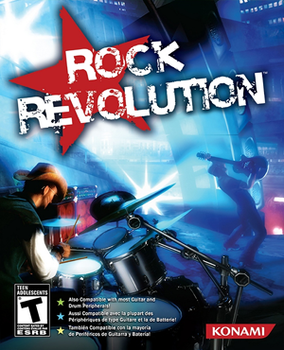
Rock Revolution is a music video game developed by Zoë Mode and HB Studios and published by Konami. The game was released on 15 October 2008 for the Nintendo DS, PlayStation 3, Wii and Xbox 360. As with similar titles, the game uses various controllers to simulate the performance of rock music, primarily using guitar and drum controllers on its Xbox 360 and PlayStation 3 versions.

A game backup device, informally called a copier, is a device for backing up ROM data from a video game cartridge to a computer file called a ROM image and playing them back on the official hardware. Recently flash cartridges, especially on the Game Boy Advance and Nintendo DS platforms, only support the latter function; they cannot be used for backing up ROM data. Game backup devices also make it possible to develop homebrew software on video game systems. Game backup devices differ from modchips in that modchips are used in conjunction with systems that use generally available media such as CDs and DVDs, whereas game backup devices are used with systems that use cartridges.

The Nintendo Entertainment System (NES) is an 8-bit third-generation home video game console produced by Nintendo. It was first released in Japan in 1983 as the Family Computer (FC), commonly referred to as Famicom. It was redesigned to become the NES, which was released in American test markets on October 18, 1985, and was soon fully launched in North America and other countries.

Atari 2600 homebrew is a term describing hobbyist-developed games for the Atari 2600 video game console. The first such game was written in 1995, and more than 100 have been released since then. The majority of games are unlicensed clones of games for other platforms, and many were written for the technical challenge. There are also ROM hacks and some original games. Several games have received attention outside the hobbyist community. Some have been included in a game anthology by Activision.
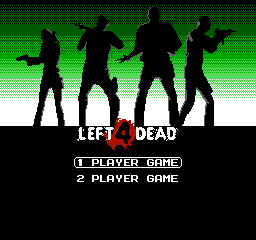
Pixel Force: Left 4 Dead is a fan-made, 8-bit-styled demake of Valve's 2008 first-person shooter game Left 4 Dead. It was developed by indie developer Eric Ruth Games and released as freeware on January 4, 2010. It was designer Eric Ruth's first attempt at an 8-bit demake, with the most difficult part for Ruth being the music composition due to Left 4 Dead's soundtrack depth and the limited audio that Ruth could work with. Pixel Force: Left 4 Dead allows players to control one or more of four survivors. It is an overhead shooter, similar to NES games Ikari Warriors and Fester's Quest. It was the first of the Pixel Force series, followed by Pixel Force: Halo and Pixel Force: DJ Hero.
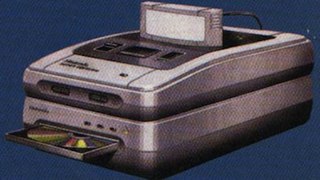
The Super NES CD-ROM System, known as the Super Famicom CD-ROM Adapter in Japan, is an unreleased add-on for the Super Nintendo Entertainment System (SNES) video game console. It built upon the functionality of the cartridge-based SNES by adding support for a CD-ROM-based format known as Super Disc.

Nintendo 64 Game Pak is the brand name of the ROM cartridges that store game data for the Nintendo 64. As with Nintendo's previous consoles, the Game Pak's design strategy was intended to achieve maximal read speed and lower console manufacturing costs through not integrating a mechanical drive, with a drawback of lower per dollar storage capacity compared to a disk. From the console's first year from late 1996 through 1997, Game Pak sizes were 4 to 12 megabytes with a typical third party retail price of US$75.99, then available in 32 megabytes in 1998, and finally 64 megabytes from 1999 onwards.

The Evercade is a handheld game console developed and manufactured by UK company Blaze Entertainment. It focuses on retrogaming with ROM cartridges that each contain a number of emulated games. Development began in 2018, and the console was released in May 2020, after a few delays. Upon its launch, the console offered 10 game cartridges with a combined total of 122 games.















